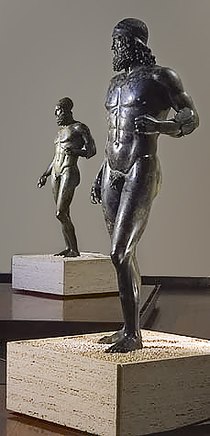APXAIA EΛΛAΣ
 Οἱ πολεμιστὲς τοῦ Riace,
Οἱ πολεμιστὲς τοῦ Riace,
εἶναι δύο διάσημα ἑλληνικὰ μπρούντζινα γλυπτά, γενειοφόρων πολεμιστῶν. Περίπου 460-450 π.Χ.
Ἡ θέση τους κανονικὰ εἶναι στὸ Museo Nazionale della Magna Grecia στὴ Reggio Calabria τῆς Ἰταλίας. Ὠστόσο, ἀπὸ τὸ 2009, τὰ μπρούντζινα γλυπτὰ φιλοξενοῦνται στὸ Palazzo Campanella, τὴν ἔδρα τοῦ Περιφερειακοῦ Συμβουλίου τῆς Καλαβρίας (Consiglio Regionale della Calabria), ὅπου ἔχουν μεταφερθεῖ, λόγω ἐργασιῶν συντήρησης στὸ Ἐθνικὸ Μουσεῖο Magna Grecia.
Τὰ ἀγάλματα ἀνακαλύφθηκαν τὸ 1972 ἀπὸ ἕναν ψαροντουφεκὰ τὸν Stefano Mariottini, κατὰ τὴ διάρκεια κατάδυσής του, σὲ ἀπόσταση 200 μέτρων ἀπὸ τὴν ἀκτὴ τοῦ Riace καὶ σὲ βάθος 6-8 μέτρων. Τὰ ἀγάλματα εἶναι σημαντικὴ προσθήκη στὰ σωζόμενα δείγματα τῆς ἀρχαίας ἑλληνικῆς γλυπτικῆς.
Ἡ κλίση τοῦ κεφαλιοῦ τους καὶ ἡ ἀσύμμετρη διάταξη τῶν χεριῶν καὶ τῶν ποδιῶν προσθέτει κίνηση καὶ ζωντάνια. Ἐπιπλέον, τὰ μάτια τους εἶναι φτιαγμένα ἀπὸ ὀστὰ καὶ γυαλί, τὰ δόντια ἀπὸ ἀσήμι καὶ τὰ χείλη καὶ οἱ θηλές εἶναι ἀπὸ χαλκό. Παλαιότερα, εἶχαν δόρατα καὶ ἀσπίδες…
Riace bronzes
The Riace bronzes are two famous full-size Greek bronzes of nude bearded warriors, cast about 460–450 BC and housed by the Museo Nazionale della Magna Grecia in Reggio Calabria, Italy. However, from 2009, the bronzes are visible in the Palazzo Campanella, seat of the Regional Council of Calabria (Consiglio Regionale della Calabria), where they were brought due to the restoration of the Magna Grecia National Museum.
Stefano Mariottini discovered the bronzes whilst snorkeling near the end of his vacation at Monasterace, while diving at a distance of 200 metres from the Riace's coast and at a depth of 6–8 metres.
The Riace bronzes, also called Riace Warriors, are major additions to the surviving examples of ancient Greek sculpture. Their turned head does not only confer movement, but it also adds life to the sculptures. The asymmetrical layout of the arms and legs adds realism to the bronzes. Moreover, the statues' eyes are inlaid with bone and glass, while the teeth are in silver and both the lips and nipples are in copper. Formerly, they held spears and shields.
http://en.wikipedia.org/wiki/Riace_bronzes
 Οἱ πολεμιστὲς τοῦ Riace,
Οἱ πολεμιστὲς τοῦ Riace,εἶναι δύο διάσημα ἑλληνικὰ μπρούντζινα γλυπτά, γενειοφόρων πολεμιστῶν. Περίπου 460-450 π.Χ.
Ἡ θέση τους κανονικὰ εἶναι στὸ Museo Nazionale della Magna Grecia στὴ Reggio Calabria τῆς Ἰταλίας. Ὠστόσο, ἀπὸ τὸ 2009, τὰ μπρούντζινα γλυπτὰ φιλοξενοῦνται στὸ Palazzo Campanella, τὴν ἔδρα τοῦ Περιφερειακοῦ Συμβουλίου τῆς Καλαβρίας (Consiglio Regionale della Calabria), ὅπου ἔχουν μεταφερθεῖ, λόγω ἐργασιῶν συντήρησης στὸ Ἐθνικὸ Μουσεῖο Magna Grecia.
Τὰ ἀγάλματα ἀνακαλύφθηκαν τὸ 1972 ἀπὸ ἕναν ψαροντουφεκὰ τὸν Stefano Mariottini, κατὰ τὴ διάρκεια κατάδυσής του, σὲ ἀπόσταση 200 μέτρων ἀπὸ τὴν ἀκτὴ τοῦ Riace καὶ σὲ βάθος 6-8 μέτρων. Τὰ ἀγάλματα εἶναι σημαντικὴ προσθήκη στὰ σωζόμενα δείγματα τῆς ἀρχαίας ἑλληνικῆς γλυπτικῆς.
Ἡ κλίση τοῦ κεφαλιοῦ τους καὶ ἡ ἀσύμμετρη διάταξη τῶν χεριῶν καὶ τῶν ποδιῶν προσθέτει κίνηση καὶ ζωντάνια. Ἐπιπλέον, τὰ μάτια τους εἶναι φτιαγμένα ἀπὸ ὀστὰ καὶ γυαλί, τὰ δόντια ἀπὸ ἀσήμι καὶ τὰ χείλη καὶ οἱ θηλές εἶναι ἀπὸ χαλκό. Παλαιότερα, εἶχαν δόρατα καὶ ἀσπίδες…
Riace bronzes
The Riace bronzes are two famous full-size Greek bronzes of nude bearded warriors, cast about 460–450 BC and housed by the Museo Nazionale della Magna Grecia in Reggio Calabria, Italy. However, from 2009, the bronzes are visible in the Palazzo Campanella, seat of the Regional Council of Calabria (Consiglio Regionale della Calabria), where they were brought due to the restoration of the Magna Grecia National Museum.
Stefano Mariottini discovered the bronzes whilst snorkeling near the end of his vacation at Monasterace, while diving at a distance of 200 metres from the Riace's coast and at a depth of 6–8 metres.
The Riace bronzes, also called Riace Warriors, are major additions to the surviving examples of ancient Greek sculpture. Their turned head does not only confer movement, but it also adds life to the sculptures. The asymmetrical layout of the arms and legs adds realism to the bronzes. Moreover, the statues' eyes are inlaid with bone and glass, while the teeth are in silver and both the lips and nipples are in copper. Formerly, they held spears and shields.
http://en.wikipedia.org/
Δεν υπάρχουν σχόλια:
Δημοσίευση σχολίου